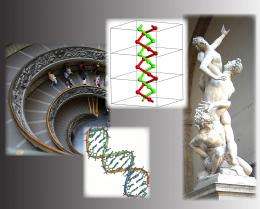Chemists do a double take on the double helix

(Phys.org) -- When most people think of a double helix, they think of DNA structure — a now familiar image thanks to Watson and Crick’s landmark 1953 discovery of the double-stranded molecules of nucleic acids. Yet human fascination with the distinctive twisted ladder-shape stretches back through ancient history, says Utah State University chemist Alexander Ivanov.
“It’s a beautiful structure and one can see many examples in art and architecture,” says Ivanov, a doctoral student in physical chemistry. “Think of Giambologna’s ‘Rape of the Sabine Women’ and Momo’s spiral staircase in the Vatican Museums.”
The geometric structure plays a significant role in metabolism and evolution. While it appears in forms great and small in varied organisms, it is very rare in inorganic chemistry.
“So, you can imagine our excitement when, using computer models, we predicted the existence of double-helix structures in simple lithium-phosphorus species,” Ivanov says.
The findings stem from a National Science Foundation-funded study Ivanov conducted with USU faculty mentor Alexander Boldyrev; his previous faculty mentor Konstantin Bozhenko of the Peoples’ Friendship University of Russia and colleagues Andrew Morris and Chris Pickard of Great Britain’s University College London. The team’s research appears in the Aug. 13, 2012, editions of Angewandte Chemie Internationale, journal of the German Chemical Society, and Chemical & Engineering News.
Finding the spirals wasn’t the initial goal of the team’s study, says Boldyrev, professor in USU’s Department of Chemistry and Biochemistry.
“We planned to probe these simple species, which consist only of lithium and phosphorus, and expected to find round, crown-like structures similar to those of sulfur compounds,” he says. “It was surprising to find the double helices.”
The findings challenge 20th century studies that suggested simpler structures for lithium-phosphorus species. With this new discovery, the chemists suspect many more inorganic compounds may also have double-helix structures.
“The new findings expand our knowledge of these compounds and have implications for future nanotechnology applications,” Boldyrev says. “Now it’s up to experimentalists to take explore our theories.”
Provided by Utah State University


















